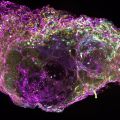
Study demonstrates how AI can develop more personalised cancer treatment strategies
University of Oxford researchers have leveraged the power of artificial intelligence (AI) to develop personalised cancer treatments which could be more effective at preventing patient relapse.
This study illustrates how combining mathematical modelling with the power of AI could have significant impact on the clinical treatment of cancer, increasing effectiveness and reducing cost.
Professor Philip Maini, Director of the Wolfson Centre for Mathematical Biology at Oxford’s Mathematical Institute, a senior authors on the study
One of the greatest challenges in cancer treatment is maximising the impact for the patient from drug treatments. Conventional treatment strategies, which focus on killing as many cells as possible, are based on a ‘maximum tolerated dose’ (MTD) therapy, where the patient continually receives a high drug dose, with no breaks in treatment. However, these frequently fail against metastatic cancers due to the emergence of drug resistance.
Adaptive therapy strategies, which dynamically adjust treatment to suppress the growth of treatment-resistant populations, have emerged as a promising alternative. However, the lack of personalized approaches that account for patient variation limits their efficacy.
In a new study published in Cancer Research, researchers from the University of Oxford and Moffitt Cancer Center in Florida introduce a novel framework that applies deep reinforcement learning, DRL, (a form of AI) to create adaptive therapy schedules for individual prostate cancer patients. The results indicate that the new adaptive approach could potentially double the time to relapse compared to MTD or non-personalised treatment breaks.
First author Kit Gallagher, a DPhil student at Oxford’s Mathematical Institute, trained the DRL network on synthetic data from a mathematical model of prostate cancer, to replicate behaviour seen in previous clinical trials. The mathematical model was vital to generate sufficiently large quantities of ‘virtual patient’ data and allowed the researchers to evaluate treatment schedules that couldn’t easily be tested clinically.
In our computational simulations, these schedules consistently outperform clinical standard-of-care protocols for cancer treatment as well as generic adaptive therapy, demonstrating how these results could be translated to support clinical decision-making.
Kit Gallagher, Mathematical Institute, University of Oxford.
The results indicated that the DRL framework consistently outperforms the conventional MTD and adaptive strategies used clinically, delaying relapse for all patients in the test cohort and more than doubling the time until relapse for some patients. It was also robust to changes or uncertainty in both the patient’s treatment response and the time interval between treatments, crucial for the real-world application of this approach.
Importantly, the researchers demonstrated that interpretable treatment strategies could be extracted from the ‘black-box’ deep learning network, in a form which a clinician would be able to understand and prescribe to their patients.
‘Interpretability has long been a significant hurdle to integrating machine learning approaches into clinical practice’ said Kit Gallagher. ‘When these frameworks are a black box, and we can’t understand how they derive treatment recommendations, we can’t be confident applying these in the clinic. But our new study shows that this hurdle can be overcome.’
The approach can even be used for patients starting new drugs, who do not have a historical record of how they respond to the treatment to inform a personalised schedule. For these cases, the researchers propose a pathway where the patients would initially start a standard treatment cycle. A ‘virtual twin’ of this patient would then be created based on their data from this initial treatment, which could be used to fine-tune the DRL model to generate a personalised treatment schedule.
The researchers are planning further studies to refine this method and explore its application to other forms of cancer.
The study ‘Mathematical Model-Driven Deep Learning Enables Personalized Adaptive Therapy’ has been published in Cancer Research. This work is supported by the National Cancer Institute.
 Schematic showing how the AI-informed adaptive therapy would work. Regular patient blood tests (1) enable the size of the tumour to be tracked. A mathematical model is applied to the data to simulate a virtual patient model (2). A generalised deep learning network is fine-tuned on the virtual patient (3), enabling the clinician to extract a practical treatment schedule that is personalised to the individual patient’s tumour and treatment history (4) to drive the next round of treatment. Image credit: Kit Gallagher, created using Biorender.com
Schematic showing how the AI-informed adaptive therapy would work. Regular patient blood tests (1) enable the size of the tumour to be tracked. A mathematical model is applied to the data to simulate a virtual patient model (2). A generalised deep learning network is fine-tuned on the virtual patient (3), enabling the clinician to extract a practical treatment schedule that is personalised to the individual patient’s tumour and treatment history (4) to drive the next round of treatment. Image credit: Kit Gallagher, created using Biorender.com Expert Comment: Chatbot-driven sexual abuse? The Grok case is just the tip of the iceberg
Expert Comment: Chatbot-driven sexual abuse? The Grok case is just the tip of the iceberg
 New study finds that stopping weight-loss drugs is linked to faster regain than ending diet programmes
New study finds that stopping weight-loss drugs is linked to faster regain than ending diet programmes
 Major funding for Oxford will help find new cancer treatments
Major funding for Oxford will help find new cancer treatments
 Researchers make miniature ‘bone marrows in a dish’ to improve anti-cancer treatments
Researchers make miniature ‘bone marrows in a dish’ to improve anti-cancer treatments
 New technique to analyse cancer cells’ life history could help provide personalised cancer treatment
New technique to analyse cancer cells’ life history could help provide personalised cancer treatment